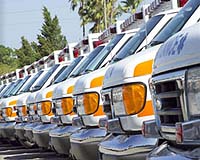 |
Cape Canaveral FL (SPX) Aug 18, 2009 The 48th successful and final Air Force Delta II Global Positioning System satellite launch occurred today, ending one of the most successful space launch programs in American history. A United Launch Alliance Delta II rocket launched GPS IIR-21(M) into orbit from Space Launch Complex-17A at 6:35 a.m., EDT today. The first Air Force Delta II GPS launch occurred Feb. 14, 1989 and today's launch marked the 48th successful GPS mission giving the program a 98 percent success rate. The first launch in 1989 was NAVSTAR II-1. NAVSTAR is now commonly known as GPS. Following a nominal 1 hour and 8 minute flight, the rocket deployed the GPS IIR-21(M) spacecraft, the eighth modernized NAVSTAR Global Positioning System Block II R-M military navigation satellite. GPS is a space-based positioning system designed and operated as a 24-satellite constellation that provides precision navigation and timing information to military and civilian users worldwide. "Congratulations to the Air Force and our mission partners in deploying this revolutionary space system that has changed the world for the better in the past 20 years," said Jim Sponnick, vice president, Delta Product Line. "One third of the 143 successful Delta II launches were GPS satellites. The ULA Delta team is extremely proud to have launched this incredible constellation. During the past two decades, the system has changed how people live their lives on a daily basis. GPS has greatly improved military operations as well as numerous maritime, aircraft, civilian and business operations worldwide." While this launch concludes the Air Force use of Delta II as it transitions its systems to Atlas V and Delta IV, the Delta II will still keep launching into the future for NASA and commercial customers. "We have the STSS Demo launch set for September, the WorldView-2 launch scheduled for October, and several more scheduled beyond those missions," Sponnick said. "The Delta II workhorse will remain the medium class launch vehicle industry standard for years to come." Designed to operate for 10 years, GPS satellites orbit the Earth every 12 hours, emitting continuous navigation signals. With the proper equipment, users can receive these signals to precisely calculate time, location and velocity. In addition to its military use, GPS satellites provide directional assistance to civilian users around the world. The ULA Delta II 7925-9.5 configuration vehicle featured a ULA first stage booster powered by a Pratt and Whitney Rocketdyne RS-27A main engine and nine Alliant Techsystems (ATK) strap-on solid rocket motors. An Aerojet AJ10-118K engine powered the second stage. A spin-stabilized Star-48B solid-rocket motor built by ATK boosted the third stage. The payload was encased by a 9.5-foot-diameter metallic payload fairing. ULA's next launch is the Department of Defense PAN mission scheduled aboard an Atlas V from SLC-41 here. A specific launch date in September has not been established. ULA program management, engineering, test and mission support functions are headquartered in Denver, Colo. Manufacturing, assembly and integration operations are located at Decatur, Ala., Harlingen, Texas, San Diego, Calif., and Denver, Colo. Launch operations are located at Cape Canaveral Air Force Station, Fla., and Vandenberg Air Force Base, Calif. Share This Article With Planet Earth
Related Links United Launch Alliance GPS Applications, Technology and Suppliers
 Is GPS Fleet Tracking The Answer To Falling Profits
Is GPS Fleet Tracking The Answer To Falling ProfitsLondon, UK (SPX) Feb 12, 2009 Times are difficult, especially for SMEs with vehicle fleets. Fleet costs continue to rise while business slows. In some cases, drivers don't do all that they can to be most productive and mitigate costs. And time is always an issue. SME owners work an average of 15 hours more than the general population according to a survey by 02. Fleet owners also deal with a host of other daily ... read more |
|
| The content herein, unless otherwise known to be public domain, are Copyright 1995-2009 - SpaceDaily. AFP and UPI Wire Stories are copyright Agence France-Presse and United Press International. ESA Portal Reports are copyright European Space Agency. All NASA sourced material is public domain. Additional copyrights may apply in whole or part to other bona fide parties. Advertising does not imply endorsement,agreement or approval of any opinions, statements or information provided by SpaceDaily on any Web page published or hosted by SpaceDaily. Privacy Statement |